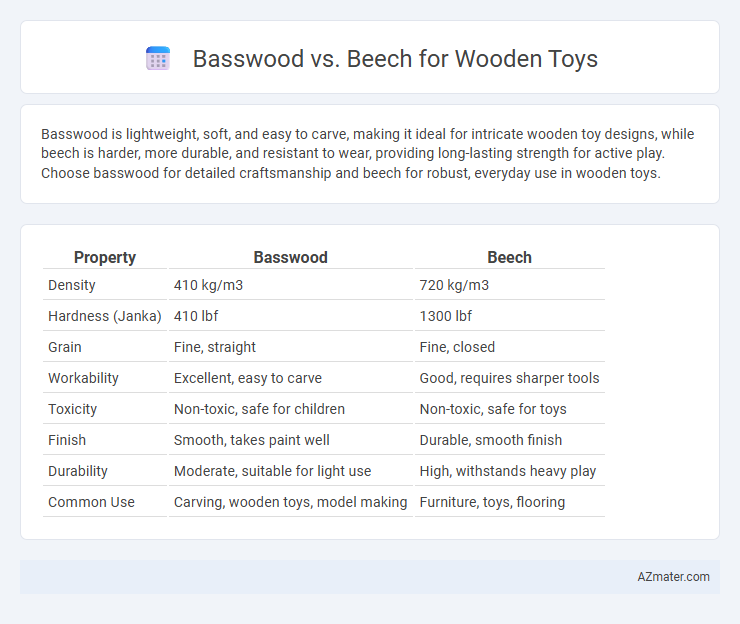Basswood is lightweight, soft, and easy to carve, making it ideal for intricate wooden toy designs, while beech is harder, more durable, and resistant to wear, providing long-lasting strength for active play. Choose basswood for detailed craftsmanship and beech for robust, everyday use in wooden toys.
Table of Comparison
| Property | Basswood | Beech |
|---|---|---|
| Density | 410 kg/m3 | 720 kg/m3 |
| Hardness (Janka) | 410 lbf | 1300 lbf |
| Grain | Fine, straight | Fine, closed |
| Workability | Excellent, easy to carve | Good, requires sharper tools |
| Toxicity | Non-toxic, safe for children | Non-toxic, safe for toys |
| Finish | Smooth, takes paint well | Durable, smooth finish |
| Durability | Moderate, suitable for light use | High, withstands heavy play |
| Common Use | Carving, wooden toys, model making | Furniture, toys, flooring |
Introduction: Basswood vs Beech for Wooden Toys
Basswood is highly favored for wooden toys due to its lightweight, fine grain, and soft texture, making it easy to carve and safe for children. Beech, known for its hardness and durability, offers a more robust option suited for toys that require greater resilience and longevity. Choosing between basswood and beech depends on the desired strength and finish of the wooden toy, balancing ease of crafting with lasting durability.
Wood Properties: Basswood and Beech Compared
Basswood offers a lightweight, fine-grained texture with excellent softness, making it ideal for delicate wooden toys and easy carving. Beech, known for its hardness and durability, provides a robust structure with a tight grain that resists dents and wear, suitable for toys subjected to rough handling. The choice between basswood and beech depends on the desired balance between ease of shaping and long-term resilience in wooden toy manufacturing.
Safety Considerations for Wooden Toys
Basswood is widely preferred for wooden toys due to its softness, making it less likely to splinter and cause injury, thus enhancing child safety. Beech, while harder and more durable, poses a greater risk of sharp splinters if not properly finished, necessitating careful sanding and sealing. Non-toxic, lead-free finishes should be applied to both woods to ensure they meet safety standards for children's toys.
Workability and Crafting Ease
Basswood offers superior workability for wooden toy crafting due to its fine, even grain and softness, allowing detailed carving and smooth finishes with minimal effort. Beech, while harder and denser, provides durability but requires sharper tools and more skill to achieve the same level of detail as basswood. For toy makers prioritizing ease of crafting and intricate designs, basswood is the preferred material.
Durability and Longevity in Play
Basswood offers moderate durability with a fine, even grain that resists splintering, making it safe for wooden toys but more prone to dents and wear compared to hardwoods. Beech boasts superior hardness and density, ensuring excellent resistance to impact and prolonged use, which enhances the longevity of wooden toys under rigorous play conditions. For toys expected to endure heavy handling, beech provides better durability and lifespan, while basswood suits lighter, detailed carvings requiring a smoother finish.
Surface Finish and Paint Compatibility
Basswood features a fine, even grain that absorbs paint smoothly, creating a flawless surface finish ideal for detailed wooden toys. Beech, with a denser texture and slightly open grain, may require additional sanding and priming to achieve a similarly smooth finish and optimal paint adhesion. Both woods are safe for kids' toys, but basswood's superior paint compatibility offers enhanced durability and vibrancy for colorful designs.
Cost and Availability of Basswood vs Beech
Basswood is generally more affordable and widely available than beech, making it a popular choice for wooden toys due to its cost-effectiveness. Beech tends to be more expensive and less abundant, as it is a hardwood that requires longer growing periods and more intensive processing. Availability of basswood in bulk and its consistent supply from North American and European sources contribute to its lower price and easier procurement for toy manufacturers.
Environmental Impact and Sustainability
Basswood, a fast-growing hardwood, offers a low environmental impact due to its rapid renewable cycle and minimal pesticide use, making it a sustainable choice for wooden toys. Beech, while durable and dense, requires longer growth periods and more intensive forestry practices, resulting in a higher environmental footprint compared to basswood. The eco-friendliness of basswood enhances sustainability efforts in wooden toy manufacturing by reducing deforestation and promoting responsible sourcing.
Best Uses for Each Wood Type in Toy Making
Basswood offers a soft, lightweight texture ideal for intricate wooden toy carving, making it a favorite for detailed figurines and educational blocks where smooth finishes and non-toxicity are essential. Beech, known for its density and durability, excels in toys subjected to heavy use, such as building sets and rolling toys, providing enhanced resistance to impact and wear. Choosing between Basswood and Beech depends on the toy's intended function: Basswood for delicate, lightweight designs and Beech for robust, long-lasting play items.
Conclusion: Choosing the Ideal Wood for Wooden Toys
Basswood offers a softer texture that is easier to carve and safer for young children, making it ideal for intricate wooden toys and detailed designs. Beech, known for its durability and fine grain, provides strength and longevity, making it suitable for toys that endure rough handling. Selecting between basswood and beech ultimately depends on the desired balance between ease of crafting and the toy's durability requirements.

Infographic: Basswood vs Beech for Wooden Toy
 azmater.com
azmater.com